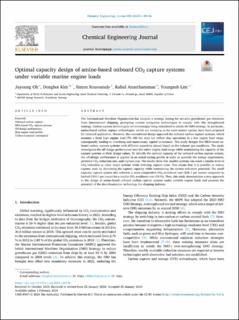| dc.contributor.author | Oh, Juyoung | |
| dc.contributor.author | Kim, Donghoi | |
| dc.contributor.author | Roussanaly, Simon Nathanael | |
| dc.contributor.author | Anantharaman, Rahul | |
| dc.contributor.author | Lim, Youngsub | |
| dc.date.accessioned | 2024-02-22T12:03:37Z | |
| dc.date.available | 2024-02-22T12:03:37Z | |
| dc.date.created | 2024-02-02T08:11:39Z | |
| dc.date.issued | 2024 | |
| dc.identifier.issn | 1385-8947 | |
| dc.identifier.uri | https://hdl.handle.net/11250/3119334 | |
| dc.description.abstract | The International Maritime Organization has adopted a strategy aiming for net-zero greenhouse gas emissions from international shipping, prompting various mitigation technologies to comply with this strengthened strategy. Carbon capture technologies are increasingly being considered to satisfy the IMO strategy. In particular, amine-based carbon capture technologies, which are emerging as the most mature option, have been proposed for onboard application. However, the conventional design approach for onboard carbon capture systems, which assumes a fixed high engine load (75–100%), does not reflect ship operations in a low engine load range, consequently leading to oversizing and unnecessary capital investment. This study designs five MEA-based onboard carbon capture systems with different capacities (sizes) based on the exhaust gas conditions. The study investigates the off-design performance over the entire engine load range while maintaining the capacity of the capture systems at their design values. To identify the optimal capacity of the onboard carbon capture system, the off-design performance is applied to an actual sailing profile in order to quantify the energy requirement, potential CO2 reduction rate, and capture cost. The results show that smaller systems can reach a similar level of CO2 reduction as other larger systems while reducing capture costs. This means that it is possible to reduce capture costs by decreasing the capture capacity while maintaining the carbon reduction potential. The small capacity capture system also achieves a more competitive CO2 avoidance cost (236 € per tonne) compared to biofuel (304 € per tonne) for a similar CO2 avoidance rate (59%). Thus, this study demonstrates a new approach to the design of amine-based onboard carbon capture systems under variable engine loads and presents the potential of the decarbonization technology for shipping industry. | en_US |
| dc.description.abstract | Optimal capacity design of amine-based onboard CO2 capture systems under variable marine engine loads | en_US |
| dc.language.iso | eng | en_US |
| dc.publisher | Elsevier | en_US |
| dc.rights | Navngivelse 4.0 Internasjonal | * |
| dc.rights.uri | http://creativecommons.org/licenses/by/4.0/deed.no | * |
| dc.title | Optimal capacity design of amine-based onboard CO2 capture systems under variable marine engine loads | en_US |
| dc.title.alternative | Optimal capacity design of amine-based onboard CO2 capture systems under variable marine engine loads | en_US |
| dc.type | Peer reviewed | en_US |
| dc.type | Journal article | en_US |
| dc.description.version | publishedVersion | en_US |
| dc.rights.holder | The Authors | en_US |
| dc.source.volume | 483 | en_US |
| dc.source.journal | Chemical Engineering Journal | en_US |
| dc.identifier.doi | 10.1016/j.cej.2024.149136 | |
| dc.identifier.cristin | 2242382 | |
| dc.relation.project | Norges forskningsråd: 320260 | en_US |
| dc.source.articlenumber | 149136 | en_US |
| cristin.ispublished | true | |
| cristin.fulltext | original | |
| cristin.qualitycode | 2 | |

